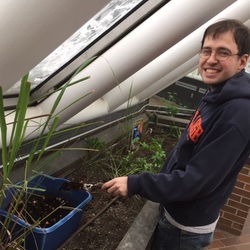
Composting with worms (or creating any kind of compost) requires you to maintain a balance between organic matter high in nitrogen (which includes most food) and organic matter rich in carbon (paper, wood, leaves, etc.) It's also important to keep the soil moist for the worms. Our worm bin has several layers. We put food scraps in at the top, and as we put more food in, the worms tend to move towards the top to eat the food. When the top layer gets full, we take the bottom layer out (which is basically humus at this point) and use it to fertilize the plants in our garden, and then put the bin on top of the previously-top layer, to allow us to begin a new layer. The material the worms leave behind is rich in nutrients for plants, helps improve the structure of the soil, and is an excellent natural fertilizer. The liquid residue from the process of vermicomposting is also a valuable resource and can be used to make compost "tea." Despite the name, it's not for drinking. We use it in our aquaponic greenhouse as a foliar spray to guard against certain pests and as a fertilizer. It's a very useful by-product of vermicomposting, and terrific stuff!

Growing Power in Milwaukee is an organization that is a pioneer in the use of vermicompost. They have two methods of doing this: the first way is through the use of a layered worm bin, similar to ours. The people at Growing Power check on the worm bins daily to make sure there's enough food for the worms, and at the end of a 12-week period, they put a new layer on and feed the worms more food. The other method used is compost piles, which contain bedding materials for the worms as well as food scraps for the worms to feast on.

http://www.motherearthnews.com/diy/garden-yard/make-worm-bin-ze0z11zhir.aspx?PageId=1#ArticleContent
http://rodaleinstitute.org/worm-bin-construction-made-simple/
I'd encourage others to have a worm composter in their home if they're interested. They're a great way to help the environment while getting back fertilizer in return.
 RSS Feed
RSS Feed
